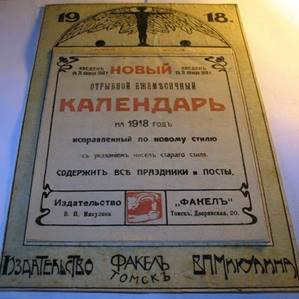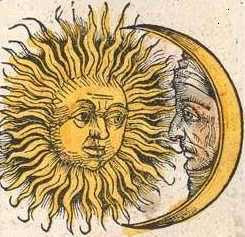
A 24-hour period (plural ancient form collision, junction meaning “the junction of day and night”) is a unit of temporal measurement, approximately equivalent to the duration of the Earth’s rotation around its axis.
Typically, a day refers to the astronomical concept of a solar day. In everyday language, a day is often referred to as a day.
A day is divided into 24 hours (1440 minutes or 86400 seconds) and comprises of day, evening, night, and morning.
Astronomy: A Day in the Life
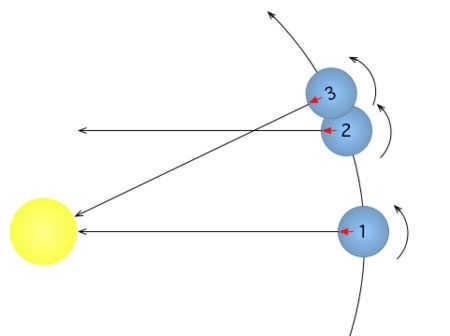
When the direction of orbital rotation and proper rotation aligns, the lengths of stellar (2) and solar (3) days can be compared.
The standard solar day is connected to an imaginary “standard Sun” – a spot that moves uniformly along the equator, completing one rotation in a year. The standard day is determined by dividing the duration of a tropical year (refer to Year), which is equivalent to 366.2422 sidereal days, into 365.2422 equal segments. The computed standard solar day is further divided into 24 hours, an hour into 60 minutes, and a minute into 60 seconds. [1]
The true solar day refers to the time period between two consecutive passages of the center of the Sun through the southern part of the meridian, which is also known as true noon. It is determined by the moment when the center of the Sun crosses the southern part of the meridian. The hour angle of the Sun’s center is known as true time, as defined in the Equation of Time. Unlike the sidereal day, the true solar day is longer and its duration varies throughout the year due to the inclination of the ecliptic to the equator and the irregular motion of the Earth near the Sun. [1]
SI system
The SI system does not officially include the value of a day, but it is permissible to use it in calculations. In these calculations, 1 day is considered to be exactly 86,400 seconds. In the field of astronomy, a day defined in this manner using SI seconds is referred to as a Julian day.
However, the average solar day does not consist of an exact whole number of seconds (for example, its duration at epoch 2000.0 was 86400.002 s), and the duration of the average solar day also varies due to the gradual change in the Earth’s rotational angular velocity. As a result, it is periodically necessary to synchronize UTC atomic Universal Coordinated Time with UT1 mean solar time (which is based on the Earth’s rotation). To achieve this synchronization, a coordinated second, known as a “leap second,” is added or subtracted from the day on either June 30 or December 31.
In the International System of Units (SI), a second is defined as 9,192,631,770 periods of radiation corresponding to the transition between the two hyperfine levels of the ground state of the cesium-133 atom. Using this precise definition, a day can be strictly defined as 794,243,384,928,000 of such transitions.
Translations in various languages.
As mentioned earlier, in everyday language the term twenty-four hours is often used interchangeably with the word day. However, in Russian, there are separate words to clearly distinguish between “day” (daylight hours) and “day” (24 hours). Similarly, other languages also have distinct words for “day”:
This holds true in many other languages that lack a distinct term for twenty-four hours.
Boundaries within different cultures
Most diurnal animals have their day start at dawn and end at dusk. Humans, on the other hand, have their own concept of the time boundaries of the day, influenced by their cultural traditions and scientific knowledge. In the Jewish tradition, the day begins at either sunset or dusk, which is when the third magnitude stars become visible. This tradition, known as “Florentine counting,” was also followed by the Christian Church and medieval Europe. Under this system, the expression “two o’clock in the afternoon” would mean “two hours after sunset.” Certain special dates, such as Christmas Eve and Halloween, still retain remnants of old customs where religious festivals would begin in the evening of the previous day. In our modern world, the convention for civil twenty-four hours is to start at 00:00 midnight (inclusive) and end a full 24 hours later, just before 24:00 (not inclusive).
Time elapses, etc., may come to an end at midnight. However, if a provider of services’ shift schedule (e.g. public transportation) spans, for instance, the time from 6:00 in the evening to 1:00 a.m. the next night (which may also be denoted as 25:00), then the final hour can legitimately be regarded as part of the previous day. For instance, a monthly bus or trolleybus pass in Russia, when valid on the 1st of the following month, remains valid until the end of the work shift of public transportation personnel, if it began on the previous day. For “Nederlandse Spoorwegen” (Dutch Railways), a daily pass is valid for 28 hours, from 0:00 to 28:00 (i.e. 4:00 of the next day). “London Regional Transport” (London public transport) passes expire at 4:30 of the day following the date of activation. [2]
Daytime Division
The number of divisions of the day or night varied depending on the level of development of a particular civilization. As humanity progressed, the number of divisions increased gradually. The indigenous peoples of the Americas, for example, divided the day into four parts: sunrise, midday, sunset, and midnight. In the 18th century, the Icelanders divided the day into 10 parts, as noted by the traveler Gorrebow. The Arabs, on the other hand, recognized fewer divisions, including only sunrise, sunset, dusk, night, the crowing of the rooster, and dawn. Some uncivilized peoples, such as those in the Society Islands during Cook’s time, had a more precise division of the day into 18 parts. However, the length of these intervals was unequal, with the shortest corresponding to morning and evening, and the longest to midnight and noon. [3]
In the Russian language, aside from the four fundamental words used to denote daily time intervals (morning, day, evening, and night), there exist additional conventional designations: thenno, dawn (dawn), sunrise, noon, midday, evening, zasvetlo, sunset, dusk, twilight, midnight, and midnight.
Division into 24 main parts
In contemporary timekeeping systems, it is widely acknowledged to partition the day into 24 hours of equal duration.
For the first time, a similar division of days (although with different hour lengths) was discovered in Ancient Egypt around 2100 BC. This system was used by Egyptian priests as a means of time orientation. It consisted of 24 hours, which included one hour of morning twilight, ten hours of daylight, one hour of evening twilight, and twelve hours of night. Around 1300 B.C., the daily time system underwent a reform. The light and dark hours of the day were divided into 12 parts each, resulting in varying durations of “day” and “night” hours depending on the season. [4]
In ancient Rome, the daylight hours were divided into four equal time segments, while the nighttime hours were combined into four “guards” or guard periods, each lasting three hours: two before midnight and two after. [5]
During medieval Europe, the daily time was categorized based on church services, which were measured according to the ancient Roman diurnal calculation. [5] (Refer to the Liturgy of the Hours for more information)
In the Novgorod Republic, the daylight hours were also divided into 12 segments, similar to 15th century Moscow. This can be inferred from the reports of Metropolitan Philip I’s death. [6]
In the 16th and 17th centuries, Russia used the diurnal method of measuring time. During this period, the duration of an hour remained constant, but the number of “day” and “night” hours fluctuated depending on the month of the year. The number of these hours ranged from 7 to 17. [7] Church services adhered to this schedule until 1722 when the synod abolished it. The European hours were then adopted, and the start of the day shifted from morning to midnight. [6]
| November 27 – January 1 | 7 | 8:30 | 17 | 15:30 |
| January 2-16 November 11-26 | 8 | 7:21 | 16 | 15:21 |
| January 17 – February 1; October 26 – November 10 | 9 | 7:30 | 15 | 16:30 |
| February 2-17; October 10-25 | 10 | 6:21 | 14 | 16:21 |
| February 18 – March 5; September 24 – October 9 | 11 | 6:30 | 13 | 17:30 |
| March 6-20; September 8-23 | 12 | 5:21 | 12 | 17:21 |
| March 21 – April 5; August 23 – September 7 | 13 | 5:30 | 11 | 18:30 |
| April 6-22; August 7-22 | 14 | 4:21 | 10 | 18:21 |
| April 23 – May 8; July 23 – August 6 | 15 | 4:30 | 9 | 19:30 |
| May 9-24; July 6-22 | 16 | 3:21 | 8 | 19:21 |
| May 25 – July 5 | 17 | 3:30 | 7 | 20:30 |
Division into 12 main parts
Since the Han Dynasty (206 B.C.E. to 220 A.D.), China has had a tradition of dividing the day into 12 equal parts based on the twelve astrological animals. This ancient tradition later spread to Japan, Korea, and Vietnam. Each astrological animal was given a specific time, known as an “hour.” For example, there was the “Hour of the Rat” (midnight) and the “Hour of the Horse” (noon) [8]:
| 23:00-1:00 | “Rat Hour” | During this time, rats are most active in their search for food. Rats also symbolize “turning around” and “new beginnings” due to their different numbers of toes on their front and back paws. |
| 1:00-3:00 | “Bull Hour” | This is the time when oxen begin to chew their cud slowly and with enthusiasm. |
| 3:00-5:00 | “Tiger Hour” | At this time, tigers are at their most ferocious, prowling for prey. |
| 5:00-7:00 | “Rabbit Hour” | During this time, the legendary Jade Rabbit on the Moon prepares herbal elixirs to assist people. |
| 7:00-9:00 | “Dragon Hour” | This is the time when dragons soar through the sky and make it rain. |
| 9:00-11:00 | “Snake Hour” | During this time, snakes leave their shelters. |
| 11:00-13:00 | “Horse Hour” | At this time, the sun is high in the sky, and while other animals rest, horses remain on their feet. |
| 13:00-15:00 | “Sheep Hour” | During this time, sheep and goats eat grass and urinate frequently. |
| 15:00-17:00 | “Monkey Hour” | This is a time when monkeys are active. |
| 17:00-19:00 | “Rooster Hour” | During this time, roosters begin to gather in their communities. |
| 19:00-21:00 | “Dog Hour” | This is the time for dogs to fulfill their duties of guarding buildings. |
| 21:00-23:00 | “Pig Hour” | During this time, pigs sleep peacefully. |
Division into 30 major parts
India’s ancient practice of dividing the day into segments is evident in the Atharva Veda. According to this tradition, the daylight portion of the day was divided into five time periods: “Udyan Surya” (sunrise), “Samgava” (cow gathering), “Madhyam-dina” (noon), “Aparahna” (afternoon), and “Astam-yan” (sunset). In Vedic literature, the days were further divided into equal intervals, not into 24 hours, but into 30 “muhurta” (which, according to modern calculation, is equivalent to 48 minutes). Each “muhurta” consisted of 15 “kshipra” (1 kshipra = 3 minutes 12 seconds), and each “kshipra” was made up of 15 “etarhi” (1 etarhi = 12.8 seconds). Finally, each “etarhi” contained 15 “idani” (1 idani = 0.85 seconds). [9]
The classification into 22 primary segments
The calendar of the ancient Maya civilization also included a unique method for measuring daily time. Similar to the ancient Egyptians in the “Old World”, the Maya divided the day into distinct day and night hours of varying lengths (a total of 22 segments). However, unlike the Egyptian system, the Maya day comprised not 12 hours, but thirteen, and the number of night hours was nine. [10]
Alterations in the Duration of Daylight
The Earth’s rotation gradually slows down due to the gravitational pull of the Moon, resulting in visible effects such as tides. As a result, the length of a day on Earth increases by approximately 2 milliseconds every century.
The verification of the change in day length over geological time has been conducted through experimental methods, specifically by examining the ring lines in fossil corals. These corals produce rings made of calcium carbonate on their outer skeleton, and the formation of these rings is influenced by both daylight and seasonal changes. In 1963, the renowned American paleontologist John Wells (1907-1994) made a significant discovery: by analyzing the ring formations on the epithecium of corals, it is possible to determine the number of days in a year during the epoch when these corals were alive. By considering the variations in the length of the year and extrapolating backwards in time, taking into account the deceleration of the Earth’s rotation caused by the Moon’s influence, it becomes feasible to ascertain the duration of a day in a specific geological period. [11] [12] :
| Today | Quaternary | 365 | 24 hours |
| 100 million years ago | Jurassic | 380 | 23 hours |
| 200 million years ago | Permian | 390 | 22.5 hours |
| 300 million years ago | Carboniferous | 400 | 22 hours |
| 400 million years ago | Silurian | 410 | 21.5 hours |
| 500 million years ago | Cambrian | 425 | 20.5 hours |
In order to determine the length of day in the distant past, scientists relied on blue-green algae for assistance. A team of Chinese researchers from the Tianjin Institute of Geology and Mineral Resources, including Zhu Shixing, Huang Xueguang, and Xin Houtian, have been studying over 500 fossil stromatolites that are 1.3 billion years old. These stromatolites were once found near the equator and have been preserved in the Yanshan Mountains. Blue-green algae have the unique ability to react to changes in light and darkness, which is evident in their growth patterns and color variations. During the day, they appear light-colored and grow vertically, while at night they become dark-colored and grow horizontally. By studying the growth patterns of these ancient organisms, taking into account their growth rate and analyzing geological and climatological data, scientists were able to determine the annual, monthly, and daily rhythms of blue-green algae growth. The findings reveal that 1.3 billion years ago, during the Precambrian era, a day on Earth lasted between 14.91 and 16.05 hours, and a year consisted of 546 to 588 days. [13]
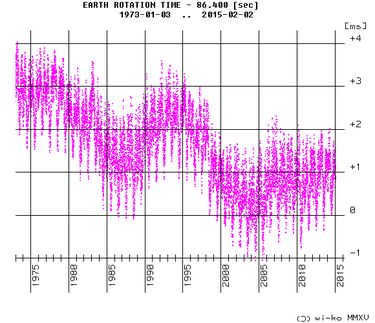
“Sutki” in Russian sayings
- Day and night – a whole twenty-four hours.
- Each day brings its own charm.
- Two hours accumulate, two hours clean, one hour rinse, twenty-four hours get ready. (referring to slowness)
Related links
- ↑ 12Time, measurement systems // Brockhaus and Efron Encyclopedic Dictionary: In 86 volumes (82 vols. and 4 supplements). – St. Petersburg. , 1890-1907.
- ↑ The information from the English Wikipedia was utilized
- ↑Astronomy // Brockhaus and Efron Encyclopedic Dictionary: In 86 volumes (82 vols. and 4 supplements). – St. Petersburg. , 1890-1907.
- ↑ E. Bickerman. Chronology of the ancient world. Near East and Antiquity. – Moscow, 1976. – P. 11-12
- ↑ 12I. N. Gansvind “Time as a cycle. The reason behind the clock face being marked 1 through 12?”
- ↑ 12By D. ProzorovskyDay, in ancient Russia // The Encyclopedia Dictionary of Brockhaus and Efron: In 86 volumes (82 vols. and 4 supplements). – St. Petersburg. , 1890-1907.
- ↑By L. V. Cherepnin "Russian Chronology," § 14. The division of twenty-four hours
- ↑ By Shelly H. Wu. (2005). Chinese Astrology. Publisher: The Career Press, ISBN 1-56414-796-7
- ↑ Historical and Astronomical Studies, XII / Ed. by L. E. Maistrov // A. I. Volodarsky "Astronomy in Ancient India" – M., Nauka, 1975.
- ↑By A. Lapin "Calendars of the ancient Egyptians and Maya".
- ↑Paleo-Astronomy (archive), J.Kovalesky Bureau des Longitudes.
- ↑Dendrochronological method of dating (medbiol.ru)
- ↑According to “Izvestia” (July 15, 2003), a billion years ago, the Earth had a year that lasted for 540 days.
- ↑The Book of Universal Delusions by John Lloyd and John Mitchinson (M.: Phantom Press, 2012) states on pages 277-278 that a billion years ago, the Earth had a year that lasted for 540 days. The book has a total of 384 pages and an ISBN number of 978-5-8-86471-624-3.
| Time – Infinity – Evidence for the existence of infinity – Immortality – Deep Time -. History – Past – Present – Future – Futurology | Portal:Time |
| Chronometry – UTC – UT – TAI – Tertia – Second – Minute – Hour – Star Time – Solar Mean Time – Time Zone Hours – Astrarium – History of time measuring instruments – Chorology – Marine Chronometer – Solar Clock – Water Clock – Hourglass – Atomic Clock Calendar – Day – Week – Month – Year – Tropical Year – Gregorian Calendar – Islamic Calendar – Julian Calendar Intercalation – Second of Coordination – Leap Year | |
| Astronomical chronology – Calendar era – Chronicles – Dating – Geochronology – Geologic time – Geologic history – Periodization – Motto rule – Timeline | |
| Dreamtime – Kala – Kalachakra (Wheel of Time) – Prophecy – Deities of time and destiny | |
| A-series and B-series – B-theory of time – Causality – Endurantism – Eternal return – Aeternalism – Eventism – Perdurantism – Presentism – Temporal finitism – Temporal portions – The Unreality of Time | |
| Time in physics – Absolute space-time – Axis of time – Chronon – Coordinate time – Fourth dimension – Planck epoch – Planck time – Proper time – Space-time – Theory of relativity – Relativistic time dilation – Gravitational time dilation – Time domain – T-symmetry | |
| Chronobiology – Circadian rhythm | |
| Mental chronometry – Sense of time – Deceptive present | |
| Long Now Foundation – Temporal routines – Chronometric time studies | |
| Absolute time in economics – Bank of time – Hour-currency – The time value of money | |
| Reconciliation of clocks – Ch time | |
| Carpe diem – Duration – Hexadecimal time – Metric time – Space – System time – Tempus fugit – Time capsule – Takt size – Time travel |
| Dawn – Dawn – Sunrise – Morning – Afternoon – Noon – Afternoon – Evening – Sunset – Dusk – Night – Midnight – Midnight – After Midnight |
| Solar Day: 24 hours – Sidereal Day: 23 hours 56 minutes 4 seconds |
| Time – Standard Time – Terminator – Polar Day – Polar Night – Longitude of the Day |
Wikimedia Foundation. 2010.
Time is an essential concept in philosophy, science, and everyday life. The measurement of time has fascinated humans for centuries, as it is closely tied to the movements of celestial bodies like the sun and moon. Although the first clocks, known as sundials, were invented around 3500 B.C., understanding and measuring time is still a complex issue. Simple questions like “how many hours are in a day?” can sometimes be difficult to answer.

Evolution of time measurement
In ancient times, people relied on the alternation of light and darkness, as well as their daily routines of sleep, work, and rest, to gauge the passage of time. The movement of the sun across the sky during the day and the appearance of the moon at night provided a natural framework for measuring time. It was only natural that people began to use the period between the same phases of these celestial bodies as a basic unit of time. As civilizations progressed, the concept of a day emerged, marking the transition from one date to another. Building upon this foundation, smaller units of time such as hours, minutes, and seconds were introduced.
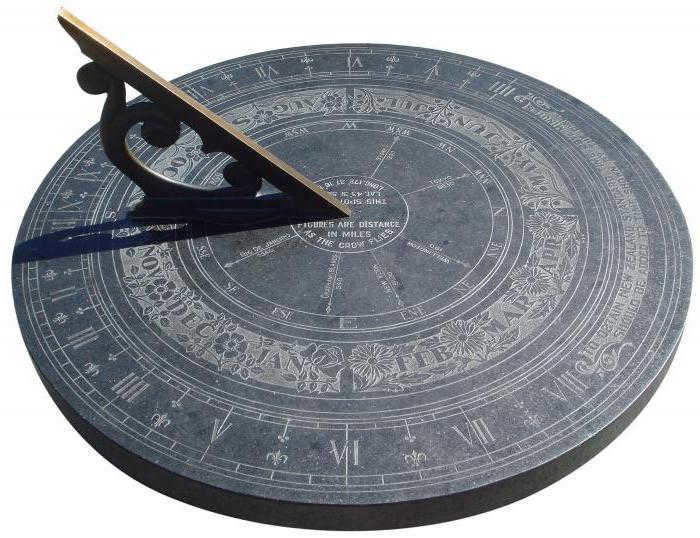
The determination of the number of hours in a day can be traced back to ancient times. The advancement of astronomical knowledge led to the division of day and night into equal intervals based on the ascent of specific constellations to the celestial equator. Additionally, the Greeks adopted the hexadecimal numeral system from the ancient Sumerians due to its practicality.
What’s the reasoning behind the choice of 60 minutes and 24 hours?
Ancient civilizations had a simple and accessible tool for counting – their fingers. This led to the development of the decimal numbering system that is widely used today. However, there was also another method that emerged in Egypt and Babylon, which was based on the phalanges of the four fingers on the left hand. This method gained significance in the culture and science of the Sumerians and other medieval civilizations, and the number 60 became revered. The number 60 was particularly useful because it had many divisors, including 12, which made it easy to divide without any remainder.
The ancient Greeks were the first to develop the concept of measuring time in hours. They divided the day into 12 equal intervals based on the daylight hours from sunrise to sunset. They also divided the night time in the same way, resulting in a 24-part division of the day. The Greeks were aware that the length of the day varied throughout the year, so they had different lengths for day and night hours, which only aligned on the days of equinox.
The Greeks borrowed the idea of dividing a circle into 360 degrees from the Sumerians. This concept was later used to develop the system of geographical coordinates. They also divided the hour into minutes (which means “the reduced first part” in Latin) and seconds (which means “the second division” in Latin).
The duration of a day, in terms of the interaction of celestial objects, refers to the length of time it takes for the Earth to complete one full revolution around its axis of rotation. Scientists, specifically astronomers, often provide additional explanations regarding this concept. They differentiate between solar days, where the start and end of the rotation are determined by the position of the Sun on the celestial sphere, and further categorize them as either true or average.

It is not possible to determine the exact duration of true solar hours in a day without specifying a specific date. The duration of these hours fluctuates by almost a minute throughout the year. This variation is caused by the complex and uneven path of the sun on the celestial sphere, as the planet’s axis of rotation has a tilt of about 23 degrees relative to the plane of the celestial equator.
Approximately, we can estimate the number of hours and minutes in a day, which are commonly known as average solar time. These are the typical time intervals that we use in our daily lives to determine a specific date. It is commonly believed that their duration is fixed, with exactly 24 hours, or 1440 minutes, or 86,400 seconds. However, this statement is not entirely true. It is known that the rotation rate of the Earth is gradually slowing down (the length of a day increases by 0.0017 seconds every century). The speed of the planet’s rotation is influenced by complex gravitational interactions with celestial bodies and internal geological processes.
Sidereal Days
In modern space ballistics, navigation, and other calculations, there is a need for precise measurements of the duration of a day down to the nanosecond. To achieve this level of accuracy, scientists have turned to more stable reference points in space rather than relying on nearby celestial bodies. By calculating the full rotation of the Earth, starting from its position relative to the vernal equinox, the length of a day can be determined. This type of day is known as a sidereal day.
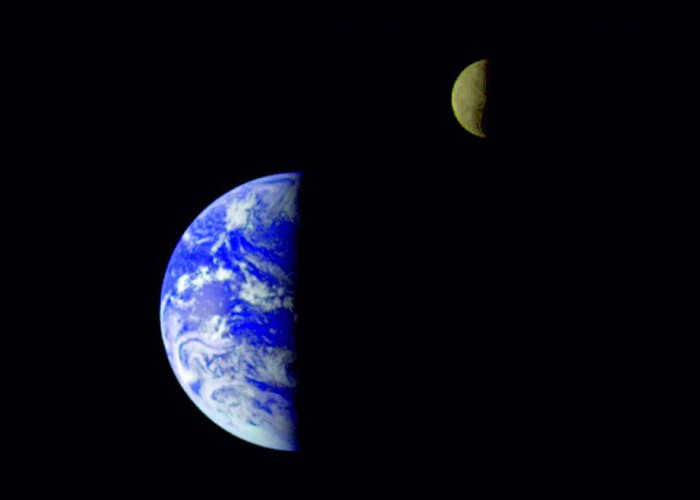
Modern science accurately determines the duration of a day, which is commonly referred to as a stellar day, to be 23 hours 56 minutes 4 seconds. In certain cases, its precise length is even further specified, with the true number of seconds being 4.0905308333. However, even with these refined measurements, there is still a factor of non-uniformity due to the orbital motion of the planet. To eliminate this factor, a unique reference point is chosen, which is associated with extragalactic radio sources.
Time and calendar
The Julian calendar, introduced in ancient Rome, established the final version of determining the number of hours in a day that is similar to the modern system. In contrast to the ancient Greek method of timekeeping, the day was divided into 24 equal intervals, regardless of the time of day or season.
Various cultures have their own calendars, which are often based on specific events of religious significance. However, the duration of an average solar day remains the same across the entire Earth.
The measurement of time is derived from a recurring natural event known as a day, which signifies the duration in which the Earth completes a full rotation on its axis. The Earth’s daily rotation establishes the pattern of day and night, influences various processes on our planet, and serves as a reference for human life and activities. This natural phenomenon has been utilized as a means of timekeeping since ancient times due to its logical and practical nature. To determine the length of a day, one can observe the positions of two consecutive peaks in the starry sky and calculate the time it takes for the Earth to move between them.
However, determining a twenty-four hour day presents practical challenges due to conflicting requirements for selecting a time unit. Currently, three reference points are utilized to establish a day: the vernal equinox point, the center of the true sun, and the center of the mean sun. Each reference point yields a different length of day, necessitating the use of all three time units of measurement – sidereal day, true solar day, and mean solar day. These measurements are respectively referred to as sidereal time, true solar time, and mean solar time. Employing these methods to determine the day complicates certain arithmetic problems, but enables a comprehensive alignment of time calculation with human life practices and enhances accuracy in time measurement using astronomical techniques.
The measurement of short intervals of time is done using the day and its parts, while longer intervals are measured using the concept of a year. The tropical year is the interval between two consecutive passages of the current sun through the point of the vernal equinox ( ^ ) and is equal to 365 d, 2422 s.d. (average solar day).
Due to the shift of the Earth’s axis, the point of the vernal equinox slowly moves towards the Sun. As a result, the Sun does not reach the same point in the sky in a tropical year, but rather in a sideral period.
The sideric year is the period of time during which the Earth completes one revolution around the Sun relative to a fixed position. It lasts for 365 d, 2568 d.y.
In the last 30 years, there has been a tenfold improvement in the precision of measuring the length of a day through astronomical observations, reducing the margin of error from 0.001 per day. This advancement has also enhanced the accuracy of astronomical pendulum and quartz clocks. Additionally, new clocks utilizing molecular and atomic technology have been created, which can measure time with a precision of 5-10^-8 seconds per day, meeting the stricter demands of certain scientific organizations.
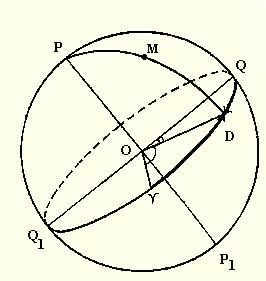
The determination of a sidereal day is based on the apparent movement of the vernal equinox point around the Earth. The moment when this point reaches its highest position is considered the start of a new day. The duration between two consecutive high points of the vernal equinox on the same meridian is known as a sidereal day.
A sidereal day is divided into 24 sidereal hours, each of which is further divided into 60 sidereal minutes, and each sidereal minute is divided into 60 sidereal seconds. The time it takes for the vernal equinox point to travel from its highest point and reach a specific position, expressed as a fraction of a sidereal day, is referred to as a sidereal hour.
The hour angle of the vernal equinox is equivalent to the sidereal time at that moment when expressed in hour measurement. The hour angle of the vernal equinox corresponds to the elapsed time since the beginning of the day. Stars with precisely defined coordinates are utilized to determine it.
If we calculate the hour angle of any star M (Fig. 1), the sidereal hour (Q1Q) is the sum of two arcs: the arc Q1D (the direct rising of the star) and the arc DQ (the hour angle of the star). Therefore,
where α represents the right ascension and t represents the hour angle of the star. When the star is observed at upper apogee, the hour angle is zero and then:
This correlation is employed for calculating sidereal time based on observations of stars’ maximal points using a traversing device. Sidereal time finds its application in scientific and technical fields, while in daily life, sundials are utilized, which operate on a longer time scale compared to sidereal time, hence the introduction of solar time.
THE ACTUAL DAY OF THE SUN AND THE ACTUAL TIME OF THE SUN
The actual day of the sun is determined by the center of the Sun. The time interval between two successive lower peaks of the center of the solar disk on the same meridian is known as the true solar day.
Unlike sidereal days, the beginning of the solar day is shifted to nighttime, so that the entire day is referred to as the same calendar date.
The time that passes from the lowest point of the Sun’s center to its position at a given time is expressed in fractions of true solar days and is referred to as true solar time. It is represented by the letter T. It is measured based on the hour angle of the center of the Sun.
The hour angle t is measured from the southern point of the equator and increases by 12 hours as it moves from the lower to the upper zenith. Therefore,
Sun always reaches its highest point 12 hours after the current time, which is referred to as t = 0. The length of the current solar day can vary, so an average solar day is introduced to establish a standard.
SIDERIC TIME
Sideric time is the measurement of Earth’s rotation relative to a specific point on the celestial sphere known as the vernal equinox. The duration between consecutive peaks of this point is called the sideric day, which has been understood for a significant period of time.
Therefore, sidereal time serves as the fundamental basis for the entire time reference system, even though many individuals may not be aware of it, as solar time is the basis for our daily lives.
SOLAR TIME
The phrase “solar time” is not completely accurate as it encompasses two different types of solar hours: actual solar time and mean solar time. One particular variant of mean solar time is known as zone time. In order to comprehend what zone time entails, it is necessary to first grasp the concept of actual solar time.
Actual solar time is determined by the sundial. The sun reaches its highest point in the sky, known as the meridian, at noon on a sundial. The time interval between two consecutive meridian crossings forms the basis of the actual solar day.
THE TRUE SOLAR DAY
The true solar day starts and ends at noon. This method of measuring time has been used for centuries as it is a simple and natural way. However, in modern times, when precise timekeeping and uniformity is necessary, this method is not suitable due to the varying duration of the actual solar day.
Nowadays, the unit of time, the second, is measured by the time interval in which 9192631770 oscillations of electromagnetic radiation occur, with the frequency corresponding to a specific absorption line in the spectrum of cesium atoms. This measurement of a second is much more accurate than calculating it based on astronomical observations.
The reason for this is primarily due to the Earth’s elliptical orbit around the Sun, rather than a perfect circular path. This means that at times, the Earth is closer to the Sun and at other times, it is farther away. When the Earth is closer, it travels faster in its orbit, causing the Sun to appear to move across the sky more quickly. This slight deviation from the regular cycle amounts to only about 3%. At its closest point to the Sun, known as perihelion (from the Greek words peri meaning near and helios meaning Sun), the Earth is 5 million kilometers closer than at aphelion (from the Latin words apo meaning from). On average, the distance between the Earth and the Sun is about 150 million kilometers. In the northern hemisphere, there are approximately 186 days between the spring equinox and the fall equinox, while there are 179 days between the fall and spring equinoxes, resulting in a difference of about 3%. Consequently, summer in our hemisphere lasts about a week longer than winter.
Furthermore, the position from which we observe the Sun influences its time. The actual moment of noon changes by approximately one minute for each quarter degree of longitude. To counteract the initial issue – the unequal duration of solar days – astronomers have implemented mean solar time.

What is the duration of 1 sol?
Comparison of Earth and Mars days
For humans residing on Earth, the concept of time seems completely natural. Time is divided into specific intervals such as minutes, days, and months, which are based on the daily and yearly natural cycles. However, with the advancement of interplanetary exploration, the question of the duration of a day on Mars has become relevant.
A familiar 24-hour day on Earth is the time it takes for the Sun to return to the same position in the sky as observed the previous day. From the surface of our planet, we observe the movement of the Sun, eagerly awaiting its reappearance at a fixed point.
On Mars, the time it takes for one complete rotation around its axis relative to the Sun is referred to as a “sol” or “synodic” day.
There is a commonly held belief that a day is always twenty-four hours long. However, this is not entirely accurate, as the length of a day can vary due to the elliptical shape of Earth’s orbit. Therefore, when making precise calculations, it is necessary to take into account both the true and average solar day.
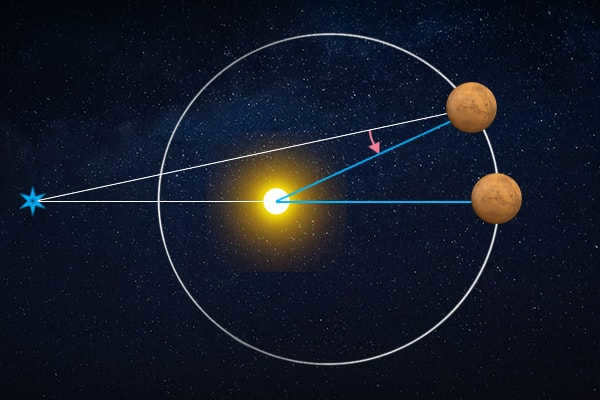
Consider the two dimensions of time – solar and stellar
Stars can also act as a point of reference. However, as our planet rotates and moves along its orbit, it also shifts slightly in relation to the celestial backdrop over the course of a day. Even when the constellations return to their original positions, a full revolution in relation to the Sun has not yet been completed. The planet requires an additional rotation on its axis. This is the distinction between solar and sidereal days.
The duration it takes for the Earth to complete one revolution in relation to the stars is known as the sidereal or sideric day.
Mars, our closest celestial neighbor, shares many similarities with Earth. It has a equatorial circumference of 21,158.52 km and rotates on its axis at a speed of 868.22 km/h. Using this information, we can calculate the length of a Martian day. Notably, the rotation speed is approximately half that of Earth’s, and the equator is also about half the length. As a result, a day on Mars differs slightly from our own:
It is impossible to determine definitively whether the day or night on Mars is longer. This is because the duration of each depends on the position of the axis in various parts of the planet, and can vary significantly.
What is a sol on Mars?
Despite the fact that the length of a day on Mars is not significantly longer, this variation poses challenges for operating space technology. Each day on Mars lasts an additional 40 minutes, causing a growing discrepancy with Earth’s calendar. To facilitate the control of Mars rovers and other equipment, a unique unit of measurement called the sol was introduced. The question then arises: how long is 1 sol on Mars and how many days does it consist of?
A sol, also known as a Martian day, has a duration of 24 hours, 39 minutes, and 35 seconds.
This information is a result of extensive astronomical observations. A Martian Sol is 1.026 times longer than a day on Earth.
Scientists have made efforts to make spacecraft control as user-friendly as possible. To achieve this, they divided each Martian Sol into twenty-four hours, similar to the twenty-four hours we are familiar with. This division is already ingrained in the human subconscious, and it would be impractical to change it. Although alternative proposals have been suggested. One of these proposals added an additional shortened interval of 39 minutes and 35 seconds to the 24 standard hours. Another proposal utilized a decimal system, dividing the day into 10 segments of 100 minutes.
Because the length of the day on Mars is longer than on Earth, the standard length of a second on the red planet is increased by 2.7%. This adjustment also affects other units of time: a minute on Mars is 1.62 seconds longer, and an hour is 1 minute and 30 seconds longer. Over time, due to rounding, a small error accumulates in the Martian calendar, and some years are designated as leap years, with one additional sol.
In the distant future, settlers on Mars will use sols as their unit of time. It is likely that the term “sols” has already become part of everyday language to avoid confusion between Earth and Martian time measurements. By convention, a day is referred to as a solar day on Earth, while on Mars it is called a sol.
Martian time
Solar panels are used to power equipment in space, accumulating charge during daylight hours. In order to effectively control this equipment, it is necessary to have knowledge of the amount of radiation reaching the surface at different times of the day. Experts are well aware of the duration of a Martian day and can calculate the amount of energy that can be extracted. However, due to the difference in length of the Martian day, a special reference frame is needed.
It is crucial to synchronize the schedules of the rovers and remote operators, primarily for the comfort of humans. When it is morning at NASA’s lab and evening in Europe, determining the appropriate time zone for Mars can be challenging. Therefore, the equipment installed on the rovers is programmed to calculate the local time and the number of hours in a Martian day.
As humans continue their exploration of the universe and strive to establish a comfortable living environment, it is crucial to have knowledge of the duration of daylight hours and sol on Mars. This information is particularly significant in coordinating the efforts of individuals from various countries who are working with extraterrestrial technology. Once time zone division becomes feasible, descent vehicles will no longer be constrained by the local time at their landing site.
Did you find the information helpful? Show your approval on social media!
- What is the distance to Mars
- Olympus Volcano, the Huge Mountain on Mars.
- Earth’s sibling, the fourth planet from the sun.
Days on Mars are longer than on Earth, which poses a potential challenge for the future colonization of the red planet. In order to coordinate the activities of the crew and equipment, it will be necessary to synchronize their work according to Martian time. To facilitate this, a separate unit of time has been introduced to measure the duration of a Martian day.
Time spent on the crimson planet
A day is a duration during which the celestial body completes a full rotation around its axis. In this instance, there exists a differentiation between the notions of synodic (solar) and sideric (sidereal) days. The former refers to the time interval it takes for the planet to revolve around its axis in relation to the Sun. The latter denotes the axial revolution in relation to the stars. The synodic and sideric days have dissimilar durations. For example, on Earth, a complete solar day encompasses 24 hours, while a sidereal day lasts 23 hours, 56 minutes, and 4 seconds.
What is the duration of a day on Mars? Calculating this time interval is not challenging. To determine it, one needs to be aware that the red planet rotates around its axis at an average speed that is twice slower compared to Earth – 868.2 km/s and 1674 km/s, respectively. However, due to Mars’ diameter being 53% smaller than Earth’s, the length of a day on both planets is nearly the same.
The duration of a day on Mars is:
Although the duration of a Martian day in hours has been accurately established, it is difficult to determine how long day and night last on the neighboring planet.
Martian Sun
Due to the difference in the length of the day on Earth and Mars, scientists studying the red planet have had to establish a new unit of time known as a sol. A sol is equivalent to the synodic period of rotation for Mars and is about 1.026 times longer than an Earth day.
To facilitate synchronization with Earth time, sols are further divided into hours, minutes, and seconds. However, these time intervals are longer than their Earth counterparts. Specifically, a Martian minute is 1.62 seconds longer than an Earth minute, and an hour on Mars lasts 61 minutes and 30 seconds.
The concept of Martian time units has also been depicted in literature. In the science fiction novel The Martian, written by American author Andy Weir, the main character Mark Watney keeps a diary using sols as his unit of time.
Calendars for colonizers
If human colonization of Mars is successful, future settlers will need to establish a calendar system that accounts for the length of Martian days and months. On Earth, we use the Gregorian calendar, which divides the time it takes for our planet to orbit the Sun (365.2425 days) into 12 months of varying lengths, ranging from 28 to 31 days.
Because of Mars’ greater distance from the Sun and its more eccentric orbit, the length of a year on Mars is longer than on Earth. Specifically, it lasts for 686.98 Earth days or 668.6 Martian sols. In order to simplify time calculations for future settlers on the red planet, they will use the Dari calendar.
The Dari calendar was developed by American engineer Thomas Gangale. In this calendar, the unit of time is 1 sol, and the year consists of 668.5907 sols. Within the Dari calendar, there are six leap years in each decade, consisting of 669 Martian days. The complete Martian year is divided into 24 months, each containing either 28 or 27 days. The shorter months occur in the sixth, twelfth, eighteenth, and twenty-fourth positions, but only in non-leap years.
Months in the Dari Calendar
The Dari calendar consists of twelve months, each named after the zodiac signs in sequential order from Sagittarius to Scorpio, as well as their corresponding Vedic counterparts. The days of the week in the Dari calendar are named after celestial objects in the solar system:
- Sol Lunae – representing the Moon (Monday);
- Sol Martis – representing Mars (Tuesday);
- Sol Mercurii – representing Mercury (Wednesday);
- Sol Jovis – representing Jupiter (Thursday);
- Sol Veneris – representing Venus (Friday);
- Sol Saturni – representing Saturn (Saturday);
- Sol Solis – representing the Sun (Sunday).
The inaccuracy of this method of measuring time is minimal: 1 sol in 100 Martian years. The Dari calendar can also be adjusted for other celestial bodies within the solar system. However, it has yet to find practical use. Currently, time on Mars is solely calculated in sols.
Solar System > Mars System > Planet Mars > Day on Mars
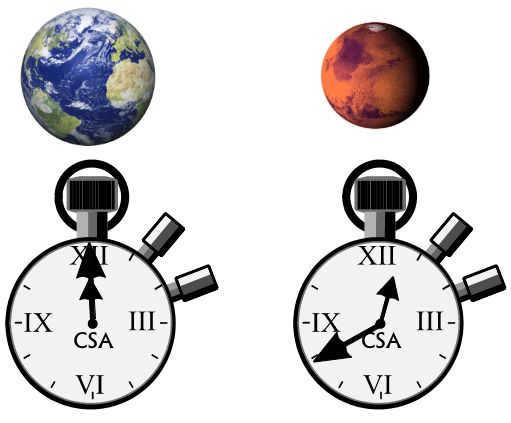
What is the duration of a day on Mars: comparing solar day and sideric sol, contrasting with Earth and examining the impact of distance from the Sun, variations in seasons, and providing a description of Martian weather.
Mars is a planet full of enigmas. On one hand, it is an icy and barren place. However, it shares many similarities with our own planet. For instance, it possesses a similar internal structure with a metallic core, a silicate mantle, and a crust resembling that of Earth. The majority of its water is concealed in the polar regions.
A Martian day lasts 40 minutes longer than an Earth day. This is the closest approximation we can make. It is crucial to grasp this distinction: scientists rely equally on the sidereal day and the solar day when conducting research.
The sideric day is the duration of one rotation of a planet around its axis. On Earth, it lasts for 23 hours, 56 minutes, and 4.1 seconds. However, Mars has a slightly longer sideric day, which is 24 hours, 37 minutes, and 22 seconds.
The solar day, on the other hand, is the time it takes for the Sun to complete a full journey across the sky and return to its original position. For Mars, this period lasts for 24 hours, 39 minutes, and 35 seconds.
Aside from these similarities in terms of days, Mars also experiences seasonal changes. This is due to its axis tilt, which is 25.19°. Additionally, the planet’s orbital path has a varying eccentricity, ranging from 206.7 million kilometers to 249.2 million kilometers. These factors contribute to significant temperature fluctuations on Mars. On average, the temperature drops to -46°C, but it can reach as low as -143°C or warm up to 35°C.
Back in 2008, scientists made a groundbreaking discovery in the polar regions – the presence of water ice deposits. While this finding was anticipated, what truly took everyone by surprise was the unexpected sight of snow falling from the clouds. This phenomenon provides a strong indication of the moist climate that prevailed in the past.
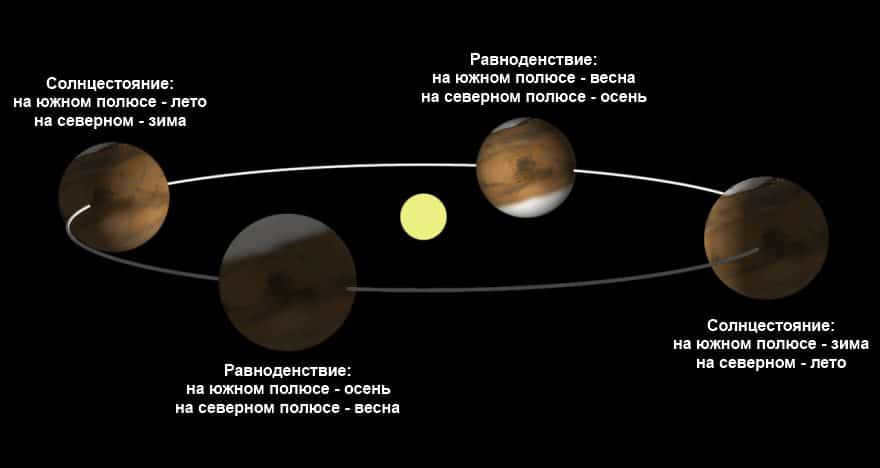
The ellipticity of the orbit of Mars results in significant fluctuations in temperature.
In 2012, the Mars Reconnaissance Orbiter (MRO) observed the occurrence of carbon dioxide snowfall in the southern polar cap. Additionally, various probes and rovers have gathered valuable information about the planet’s history over the years. Soil samples have indicated that 3.7 billion years ago, Mars had a greater amount of water on its surface compared to the current volume in the Atlantic Ocean. Furthermore, there is evidence of a thick atmospheric layer that was eroded by solar winds.
Mars experiences a weathering system, which manifests in the form of hazardous dust storms that periodically envelop the entire planet. These storms can stretch across thousands of kilometers and create a dense layer that obscures the surface from view when they intensify.
In 1971, Mariner 9 had an unfortunate experience. Upon transmitting its initial images of Mars, the storm had completely engulfed the planet’s surface. The storm was of such magnitude that only Mount Olympus, the tallest mountain, remained visible.
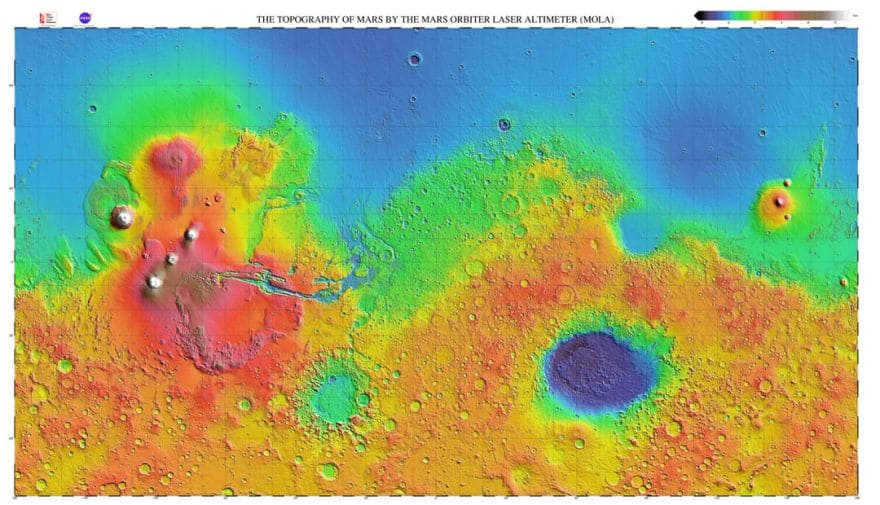
The Hellas Basin, located in the bottom right corner, is characterized by its blue coloration.
In 2001, the Hubble telescope tracked a dust storm that occurred over the Hellas Basin, marking it as the largest dust storm in the past 25 years. Even amateur astronomers had the opportunity to observe this phenomenon.
Another notable aspect of Mars is its global warming. The Martian atmosphere contains particles that absorb solar energy and transfer it to the atmospheric layer, resulting in an increase in temperature.
Storms tend to occur more frequently as the planet approaches its closest point to the sun. The arid soil makes it easier for dust to be kicked up into the atmosphere. It is evident that Mars is not the most hospitable place for human colonization, but the determination to colonize it remains.
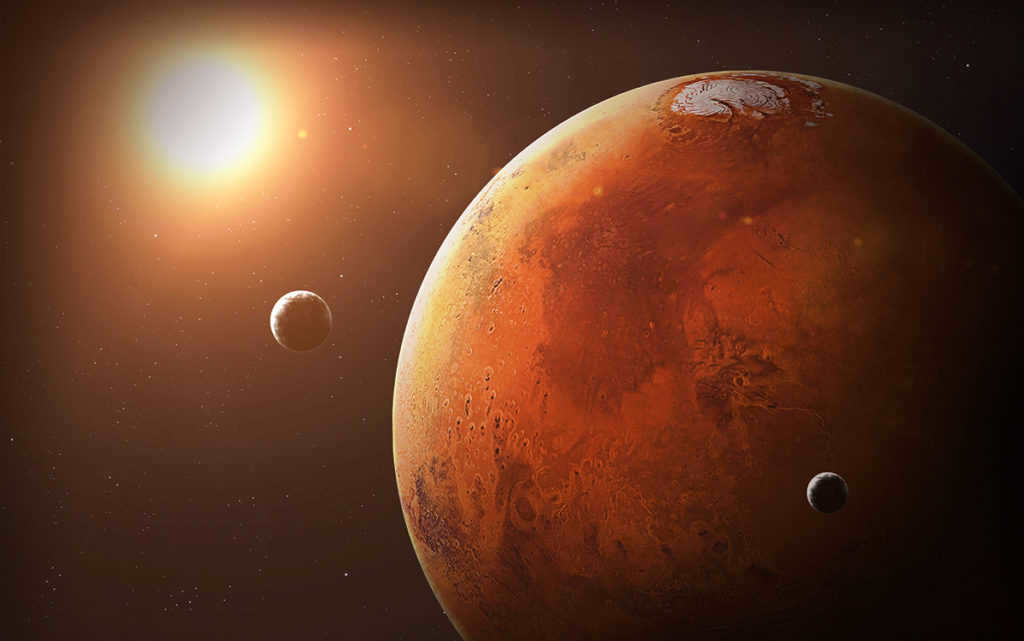
Most of the characteristics of Mars adhere to the parameters established during the formation of the solar system. The study of time, seasons, and planetary movement on Mars helps in the ongoing quest for signs of life on the Red Planet.
A Martian day, or sol, is slightly longer than an Earth day, and this time difference has posed challenges until it was identified and designated as a sol.
Perhaps the sol will serve as a stepping stone for humanity to colonize Mars, and in the distant future, the Martian day (sols) may become the standard unit of time for the planet’s inhabitants.
Space stations rely on solar energy for power, which is stored in batteries for use when the sun is not shining. In order to control the vehicles, it is necessary to know the amount of radiation received on the surface at different times of the day. Scientists can calculate this by knowing the length of a Martian day. However, since a day on Mars is longer than a day on Earth, special time measurement systems are needed.
Humans are eager to explore the universe and utilize its resources for their own purposes. To coordinate the activities of Mars rovers and the specialists who operate them, it is necessary to know the local time on the planet. Unlike Earth, Mars does not have time zones, so the landers are oriented based on local time rather than Earth time.
What is the duration of a day on Mars?
On Earth, a day is comprised of twenty-four hours, which are further divided into smaller intervals such as seconds and minutes. This division is based on the natural cycles that occur annually and daily, with 24 hours representing the time it takes for the Earth to complete one revolution around its axis.
In the realm of science, there are two types of days that are recognized: solar and stellar. A solar day refers to the number of hours it takes for one rotation on its axis. However, due to the elliptical shape of its orbit, the rotation time on Mars is not always equivalent to 24 hours. To ensure precise calculations, the concept of sidereal days is introduced.
When considering the average distance from Earth to Mars, which is approximately 228 million kilometers, it becomes apparent that Mars is the closest planet to our own. As a result, many of Mars’ properties bear similarities to those of Earth.
– Mars rotates at a speed of approximately 870 km/h at its equator.
The length of a Martian day is slightly different from that of Earth. A solar day on Mars is referred to as a “Sol” and is longer than a sidereal day.
The duration of a Martian day is:
– 24 hours and 37 minutes (sidereal).
– A Sol is equivalent to 24 hours and 39 minutes.
– According to solar measurements, the Martian night lasts for 12.2 hours.
The length of a Martian day is 24 hours and 37 minutes, making Martian sunrises and sunsets nearly coincide with those on Earth. However, the color scheme of Martian sunsets and dawns is completely different. This is influenced by:
– The distance between Mars and the Sun.
– The dust in Mars’ atmosphere.
The dust on the planet absorbs the blue hues, resulting in the warm color scheme that humans associate with the planet. During dawn, the sky takes on a blue hue, but once the Sun rises, the dust absorbs the blue again, leaving only warm colors visible to the human eye.
How long is a year on Mars?
On Earth, a year can be measured in two ways:
– Stellar time.
– Solar time.
A solar year represents the Earth’s complete orbit around the Sun, while a sidereal year refers to the orbital motion relative to non-moving celestial bodies.
The difference between these two measurements is approximately 20 minutes. Similarly, the length of a year on Mars also varies depending on the measurement used.
Mars has a slower rotation speed compared to Earth, resulting in a longer Martian year:
- Earth year: 686 days
- Martian year: 668 sols
The seasons on Mars are determined by the intervals between the equinox and solstice:
- The longest Martian spring lasts 193 sols
- Fall lasts 142 sols
The day of the equinox marks the beginning of the Martian solar year. This is necessary because Mars has an elongated, elliptical orbit, causing different measurements on other days. The planet completes one revolution around its axis at an inclination of 25 degrees.
– Spring on Mars lasts for 7-6 months.
– Summer and fall on Mars last for 5 months.
– Winter on Mars lasts for about 4 months.
The Origin of Sol
Ever since humans started exploring the Red Planet, they have encountered the challenge of keeping track of time. As a result, a unique time measurement system called sol was developed. But what exactly is sol on Mars and why is it necessary? A sol refers to a Martian day, which is different from our Earth day.
During the automated exploration of Mars, scientists faced the issue of not knowing the patterns of solar energy, which powers the rovers. This prompted the urgent need for a Martian calendar and specialized clocks that are synchronized with Mars.
Due to the slight difference in the inclination of Mars’ rotation to the orbital plane compared to Earth, the planet experiences similar seasonal periods. However, Mars’ orbit has a greater eccentricity, resulting in significantly different lengths of these periods. While Martian days are similar to Earth’s, the length of a Martian year is distinct, causing a lack of synchronization between Martian and Earth calendars. To address this issue, we have developed a specialized calendar and a new time calculation system that operates in harmony with our clocks and calendars. By understanding the solar day on Mars, operators working with Martian machinery can effectively time the flow of solar energy.

A Martian year
Similar to Earth, Mars also experiences two types of years: tropical and sidereal. The sidereal year on Mars refers to the time it takes for the planet to complete a full orbit around the Sun in relation to the fixed stars, resulting in a complete change of seasons. This period is characterized by a 360-degree shift in the Sun’s longitude. However, the tropical year on Mars, which is based on the planet’s changing seasons, differs from the sidereal year by approximately twenty minutes. This discrepancy is similar to the one observed on Earth.
By understanding the idea of “sol” on Mars and its duration, we can determine the length of a Martian year. As Mars orbits the sun at a slower pace than Earth, its year is longer – 686 Earth days, while sols are shorter – 668. If we define seasons as the periods between equinoxes and solstices, the longest period of spring in the northern hemisphere lasts for one hundred ninety-three sols, while autumn lasts for one hundred forty-two sols.
When it comes to the foundation of the Martian calendar, the tropical year is considered the most effective type of year due to the significant precession cycles on the planet. Nevertheless, the length of a tropical year can vary depending on the chosen starting point. The starting point can either be the day of the vernal equinox or the day of the solstice. However, the day of the vernal equinox is typically preferred due to Mars’ more elongated orbit, which results in different indices of the tropical year when calculated from various points of reference.

There are two types of calendars on Earth: Gregorian and Julian. The Gregorian calendar is widely used in our everyday life due to its convenience. Based on this, scientists have concluded that it would be more convenient for future Martian colonies to follow a cyclic (Gregorian) calendar as well. However, this calendar encounters a minor issue – leap years. In our calendar system, a correction is made every four years to account for the discrepancy between the tropical year and our calendar. The same issue arises on Mars.
There is a suggestion by T. Gangale for a unique version of Martian calendars. He devised a calendar that comprises of twenty-four months, with each month having either 27 or 28 days. This calendar follows a ten-year cycle, with six leap years lasting 669 days each and four years lasting 668 days each. Experts estimate that this calendar has the potential to have an error of 1 sol per hundred years. While this method of timekeeping is well-suited for Mars, it is not currently utilized. Astronomers and other scientists solely rely on counting sols.
There is a wealth of knowledge about Mars available to astronomers, cartographers, and other scientists. With this data, they have the potential to create a unique calendar for the planet or adapt the one created by Gangale. Interestingly, scientists already have a starting point for counting dates according to the AMT standard. On Earth, the Julian date of January 1, 4712 B.C. or November 24, 4714 in the Gregorian calendar is considered day zero. The first day of this calendar began with a countdown from zero and the dates themselves changed at noon. Similarly, a corresponding date for Mars was established in sol, which aligned with December 29, 1873 on our calendar. There were also alternative options for counting dates, such as 1608 and April 11, 1955, the day of the vernal equinox.

The movement of planets affects the way time is experienced in our lives. Our daily routines are influenced by the changing periods of day and night, as well as the seasons. In this lesson, we will explore various methods for accurately determining the time at any given location on Earth. We will examine how time measurement is connected to the Earth’s meridians and the concept of solar days. Additionally, we will delve into the significance of the date line and its geographical placement. Lastly, we will delve into different calendar systems and the underlying principles that govern them.
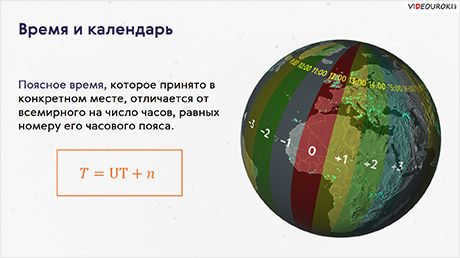
Currently, it is not possible to view or share the instructional video with students
In order to access this and other video lessons included in the package, you will need to add it to your personal account.
Unlock amazing possibilities



Lesson plan “Time and the Calendar”
Our existence is intricately intertwined with the concept of time and the cyclical patterns of day and night and the changing seasons. It is a well-known fact that the Sun only illuminates half of the Earth at any given time, resulting in daytime on one hemisphere and nighttime on the other. As a result, there are always specific locations on our planet where it is noon and the Sun is at its highest point, as well as places where it is midnight and the Sun is at its lowest point.
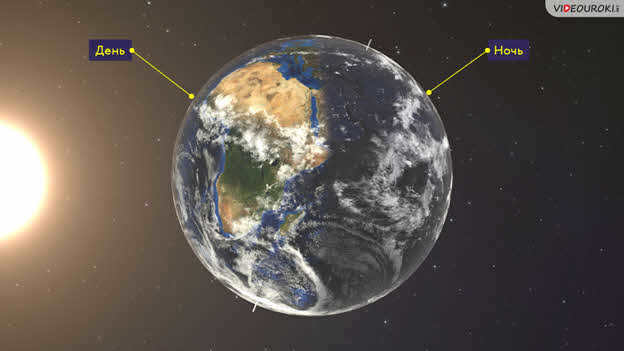
The true noon refers to the moment when the center of the Sun reaches its highest point in the sky, while true midnight is the moment when the center of the Sun reaches its lowest point. The interval between two consecutive highest points of the Sun is known as a true solar day.
It seems that they can be utilized for precise timekeeping. However, due to the Earth’s elliptical orbit, solar days undergo periodic variations in their duration. When the Earth is closest to the Sun, it orbits at a speed of approximately 30.3 km/s. After six months, the Earth reaches its farthest point from the Sun, causing its speed to decrease by 1 km/s. This uneven motion of the Earth in its orbit results in an uneven apparent movement of the Sun across the celestial sphere. In other words, the Sun seems to “move” at different speeds in the sky at different times of the year. Consequently, the duration of true solar days constantly fluctuates, making it inconvenient to use them as a standard unit of time measurement. Therefore, in everyday life, the mean solar day is employed instead. This average solar day is assumed to have a constant duration of 24 hours. Each hour of mean solar time is further divided into 60 minutes, and each minute into 60 seconds.
Measurement of time based on the solar day is associated with the geographical meridian. The time measured at a specific meridian is known as its local time, and it is consistent for all points on that meridian. However, the further eastward the meridian is, the earlier the day begins on it. Taking into consideration that our planet rotates around its axis by 15° every hour, the time difference between two points in one hour corresponds to the difference in longitudes by 15°. Therefore, the local time in two points will differ by the same amount as the difference in their geographic longitudes, expressed in hours:
T1 – T2 = λ1 – λ2.
In your geography class, you learned about the prime meridian, also known as the zero meridian, which runs through the Greenwich Observatory near London. The local mean solar time at the Greenwich meridian is referred to as Universal Time – Universal Time (UT) for short.

By knowing the Universal Time and the geographic longitude of any point, it becomes possible to easily calculate its local time:
T1 = UT + λ1.
This equation can also be used to determine the geographic longitude based on the Universal Time and local time, which can be determined through astronomical observations.
However, if we were to rely on local time in our daily lives, we would constantly need to adjust the clock hands as we move between locations to the east or west of our current position.
For example, let’s calculate how much later noon is in St. Petersburg compared to Moscow, assuming that their geographic longitudes are known in advance.
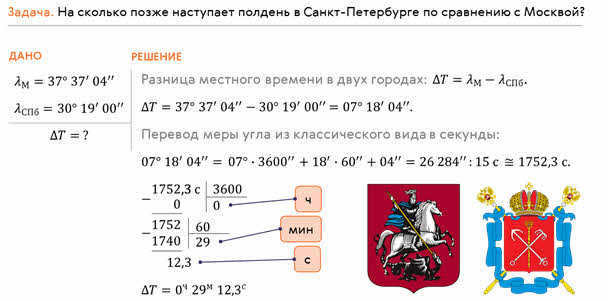
To put it differently, in St. Petersburg, noon will occur approximately 29 minutes and 12 seconds later than in Moscow.
The resulting inconvenience is so evident that nowadays nearly the entire global population employs the system of time zones. It was proposed by an American teacher named Charles Dowd in 1872 for implementation on American railroads. And already in 1884, the International Meridian Conference took place in Washington, which resulted in the recommendation to adopt Greenwich time as the universal time.
According to this system, the whole world is divided into 24 time zones, with each zone spanning 15° of longitude (or one hour). The time zone at the Greenwich meridian is regarded as zero. The remaining zones, from zero to east, are numbered from 1 to 23. Within a single zone, the time is the same at all points at any given moment, while in adjacent zones it differs by one hour.
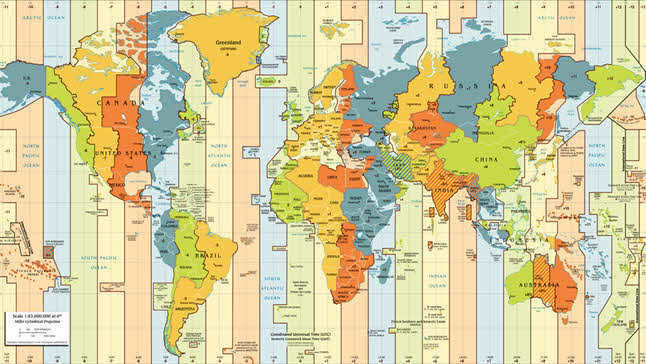
Therefore, the local time, which is observed in a specific location, varies from Coordinated Universal Time (UTC) by the number of hours corresponding to its time zone:
L = UTC + n.
When looking at the map of time zones, it becomes apparent that their boundaries coincide with meridians primarily in sparsely populated areas, such as the open seas and oceans. In more populated regions, time zone borders are often aligned with state and administrative boundaries, mountain ranges, rivers, and other natural features for convenience.
Additionally, there is an imaginary line that stretches from pole to pole across the Earth’s surface, where the local time differs by almost a full day on either side. This line is known as the International Date Line and approximately follows the 180th meridian.
In the current era, atomic time, which was established by the International Committee of Weights and Measures in 1964, is regarded as the most dependable and convenient method of measuring time. Atomic clocks have been universally adopted as the standard for timekeeping, with an error rate of roughly one second in 50 thousand years. As a result, since January 1, 1972, countries around the world have been utilizing atomic time as their basis for measuring time.
For the purpose of measuring long periods of time, which involve a specific number of months, their specific order within the year, and the starting point for counting years, the calendar was implemented. This system is derived from recurring astronomical events, such as the Earth’s rotation on its axis, the varying phases of the moon, and the Earth’s revolution around the Sun. Every calendar system (of which there are over 200) is built upon three fundamental units of time measurement: the average solar day, the synodic month, and the tropical (or solar) year.
Let us remember that the synodic month is the period of time between two consecutive identical phases of the Moon, which is approximately 29.5 days in length.
As observed, the synodic month and the tropical year do not encompass a complete number of average solar days. This discrepancy prompted numerous civilizations to devise their own methods of synchronizing the day, month, and year. Consequently, different peoples at various periods in history adopted their own unique calendar systems. Nevertheless, all calendars can be categorized into three main types: lunar, lunar-solar, and solar.
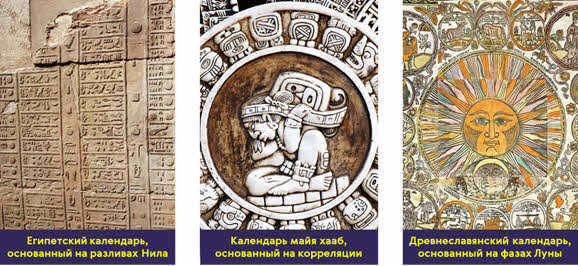
In the lunar calendar, the year is divided into 12 lunar months that alternate between 30 or 29 days. As a result, the lunar calendar is about ten days shorter than the solar year. This type of calendar is widely used in the modern Islamic world.
Lunar-solar calendars are the most intricate. They are based on the concept that 19 solar years are equivalent to 235 lunar months. Consequently, a year can consist of 12 or 13 months. Currently, this system is maintained in the Jewish calendar.
In the solar calendar, which is determined by the length of the tropical year, one of the earliest examples is the ancient Egyptian calendar, which dates back to approximately 5000 BC. This calendar divided the year into 12 months, each consisting of 30 days, with an additional 5 feast days at the end of the year.
The direct predecessor to our modern calendar is the Julian calendar, which was implemented on January 1, 45 BC in ancient Rome under the order of Julius Caesar.


The calendar that was used at that time consisted of 365.25 days, which matched the length of the tropical year. To make it more convenient, three years were considered to have 365 days each. Additionally, every fourth year had an extra day added to February, making it a leap year.
However, the Julian calendar had a flaw. The duration of the calendar year differed from the tropical year by 11 minutes and 14 seconds. While this may not seem significant, by the mid-16th century it was discovered that the day of the vernal equinox, which is important for church holidays, had shifted by 10 days.
To address this accumulated error and prevent future displacements, Pope Gregory XIII implemented a calendar reform in 1582. This reform involved moving the count of days forward by 10 days.

Simultaneously, Gregory XIII modified the leap year rule to enhance the alignment of the average calendar year with the solar year. The leap year still occurred every four years, but there was an exception for years divisible by one hundred. These years became leap years only if they were also divisible by four hundred. As an example, 1700, 1800, and 1900 were regular years, while 1600 and 2000 were leap years.
The revised calendar became known as the Gregorian calendar or the new style calendar.
In Russia, the new style calendar was not adopted until 1918. By that time, a discrepancy of 13 days had accumulated between the new and old style calendars.
